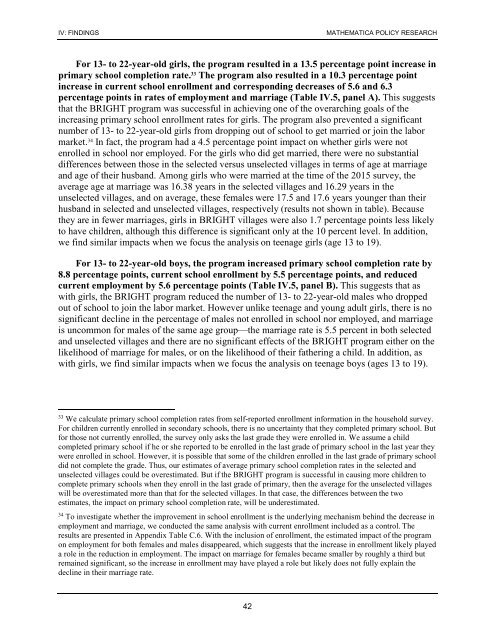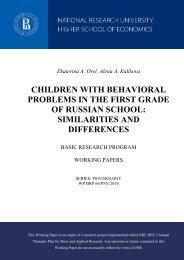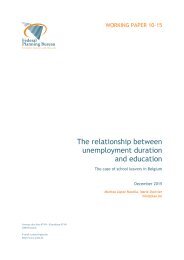Ten-Year Impacts of Burkina Faso’s BRIGHT Program
n?u=RePEc:mpr:mprres:2ecdd42bb503422b802ce20da2bf64b7&r=edu
n?u=RePEc:mpr:mprres:2ecdd42bb503422b802ce20da2bf64b7&r=edu
Create successful ePaper yourself
Turn your PDF publications into a flip-book with our unique Google optimized e-Paper software.
IV: FINDINGS<br />
MATHEMATICA POLICY RESEARCH<br />
For 13- to 22-year-old girls, the program resulted in a 13.5 percentage point increase in<br />
primary school completion rate. 33 The program also resulted in a 10.3 percentage point<br />
increase in current school enrollment and corresponding decreases <strong>of</strong> 5.6 and 6.3<br />
percentage points in rates <strong>of</strong> employment and marriage (Table IV.5, panel A). This suggests<br />
that the <strong>BRIGHT</strong> program was successful in achieving one <strong>of</strong> the overarching goals <strong>of</strong> the<br />
increasing primary school enrollment rates for girls. The program also prevented a significant<br />
number <strong>of</strong> 13- to 22-year-old girls from dropping out <strong>of</strong> school to get married or join the labor<br />
market. 34 In fact, the program had a 4.5 percentage point impact on whether girls were not<br />
enrolled in school nor employed. For the girls who did get married, there were no substantial<br />
differences between those in the selected versus unselected villages in terms <strong>of</strong> age at marriage<br />
and age <strong>of</strong> their husband. Among girls who were married at the time <strong>of</strong> the 2015 survey, the<br />
average age at marriage was 16.38 years in the selected villages and 16.29 years in the<br />
unselected villages, and on average, these females were 17.5 and 17.6 years younger than their<br />
husband in selected and unselected villages, respectively (results not shown in table). Because<br />
they are in fewer marriages, girls in <strong>BRIGHT</strong> villages were also 1.7 percentage points less likely<br />
to have children, although this difference is significant only at the 10 percent level. In addition,<br />
we find similar impacts when we focus the analysis on teenage girls (age 13 to 19).<br />
For 13- to 22-year-old boys, the program increased primary school completion rate by<br />
8.8 percentage points, current school enrollment by 5.5 percentage points, and reduced<br />
current employment by 5.6 percentage points (Table IV.5, panel B). This suggests that as<br />
with girls, the <strong>BRIGHT</strong> program reduced the number <strong>of</strong> 13- to 22-year-old males who dropped<br />
out <strong>of</strong> school to join the labor market. However unlike teenage and young adult girls, there is no<br />
significant decline in the percentage <strong>of</strong> males not enrolled in school nor employed, and marriage<br />
is uncommon for males <strong>of</strong> the same age group—the marriage rate is 5.5 percent in both selected<br />
and unselected villages and there are no significant effects <strong>of</strong> the <strong>BRIGHT</strong> program either on the<br />
likelihood <strong>of</strong> marriage for males, or on the likelihood <strong>of</strong> their fathering a child. In addition, as<br />
with girls, we find similar impacts when we focus the analysis on teenage boys (ages 13 to 19).<br />
33<br />
We calculate primary school completion rates from self-reported enrollment information in the household survey.<br />
For children currently enrolled in secondary schools, there is no uncertainty that they completed primary school. But<br />
for those not currently enrolled, the survey only asks the last grade they were enrolled in. We assume a child<br />
completed primary school if he or she reported to be enrolled in the last grade <strong>of</strong> primary school in the last year they<br />
were enrolled in school. However, it is possible that some <strong>of</strong> the children enrolled in the last grade <strong>of</strong> primary school<br />
did not complete the grade. Thus, our estimates <strong>of</strong> average primary school completion rates in the selected and<br />
unselected villages could be overestimated. But if the <strong>BRIGHT</strong> program is successful in causing more children to<br />
complete primary schools when they enroll in the last grade <strong>of</strong> primary, then the average for the unselected villages<br />
will be overestimated more than that for the selected villages. In that case, the differences between the two<br />
estimates, the impact on primary school completion rate, will be underestimated.<br />
34<br />
To investigate whether the improvement in school enrollment is the underlying mechanism behind the decrease in<br />
employment and marriage, we conducted the same analysis with current enrollment included as a control. The<br />
results are presented in Appendix Table C.6. With the inclusion <strong>of</strong> enrollment, the estimated impact <strong>of</strong> the program<br />
on employment for both females and males disappeared, which suggests that the increase in enrollment likely played<br />
a role in the reduction in employment. The impact on marriage for females became smaller by roughly a third but<br />
remained significant, so the increase in enrollment may have played a role but likely does not fully explain the<br />
decline in their marriage rate.<br />
42







